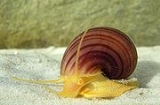
Pomacea bridgesii
Encyclopedia
- See also: Pomacea diffusaPomacea diffusaPomacea diffusa, common name spike-topped apple snail, is a species of freshwater gastropod in the family Ampullariidae.- Taxonomy :Pomacea diffusa was originally described as a subspecies of Pomacea bridgesii...
, formerly known as Pomacea bridgesii.
Pomacea bridgesii, common name
Common name
A common name of a taxon or organism is a name in general use within a community; it is often contrasted with the scientific name for the same organism...
s the Spike-topped apple snail or Mystery snail, is a South American species
Species
In biology, a species is one of the basic units of biological classification and a taxonomic rank. A species is often defined as a group of organisms capable of interbreeding and producing fertile offspring. While in many cases this definition is adequate, more precise or differing measures are...
of freshwater snail
Snail
Snail is a common name applied to most of the members of the molluscan class Gastropoda that have coiled shells in the adult stage. When the word is used in its most general sense, it includes sea snails, land snails and freshwater snails. The word snail without any qualifier is however more often...
with gill
Gill
A gill is a respiratory organ found in many aquatic organisms that extracts dissolved oxygen from water, afterward excreting carbon dioxide. The gills of some species such as hermit crabs have adapted to allow respiration on land provided they are kept moist...
s and an operculum
Operculum (gastropod)
The operculum, meaning little lid, is a corneous or calcareous anatomical structure which exists in many groups of sea snails and freshwater snails, and also in a few groups of land snails...
, an aquatic
Aquatic animal
An aquatic animal is an animal, either vertebrate or invertebrate, which lives in water for most or all of its life. It may breathe air or extract its oxygen from that dissolved in water through specialised organs called gills, or directly through its skin. Natural environments and the animals that...
gastropod mollusk in the family Ampullariidae
Ampullariidae
Ampullariidae, common name the apple snails, is a family of large freshwater snails, aquatic gastropod mollusks with a gill and an operculum...
.
Subspecies
- Pomacea bridgesii bridgesii (Reeve, 1856)
- Pomacea bridgesii diffusa (Blume, 1957)
Anatomy
Mystery snails possess structurally complex eyes at the tip of a cephalic eyestalk. These snails possess the ability to regenerate the eye completely after amputation through the mid-eyestalk. They are born with both gills and lungs.Distribution
The native distribution of this snail is BoliviaBolivia
Bolivia officially known as Plurinational State of Bolivia , is a landlocked country in central South America. It is the poorest country in South America...
, Brazil, Paraguay
Paraguay
Paraguay , officially the Republic of Paraguay , is a landlocked country in South America. It is bordered by Argentina to the south and southwest, Brazil to the east and northeast, and Bolivia to the northwest. Paraguay lies on both banks of the Paraguay River, which runs through the center of the...
and Peru
Peru
Peru , officially the Republic of Peru , is a country in western South America. It is bordered on the north by Ecuador and Colombia, on the east by Brazil, on the southeast by Bolivia, on the south by Chile, and on the west by the Pacific Ocean....
.
Non-indigenous distribution
It is non-indigenous in Hawaii since 1960 (Pomacea bridgesii diffusa), south-east Asia since 1980s and in Florida since early 1980s (Pomacea bridgesii diffusa).BlakooOffspring
Mystery snails lay their eggs above the water line, which take 2-4 weeks to hatch. They can have as many as two-hundred offspring.Human relevance
It is often kept as an aquariumAquarium
An aquarium is a vivarium consisting of at least one transparent side in which water-dwelling plants or animals are kept. Fishkeepers use aquaria to keep fish, invertebrates, amphibians, marine mammals, turtles, and aquatic plants...
pet because of its wide range of shell colors, lack of appetite for live plants, and ease of care.

